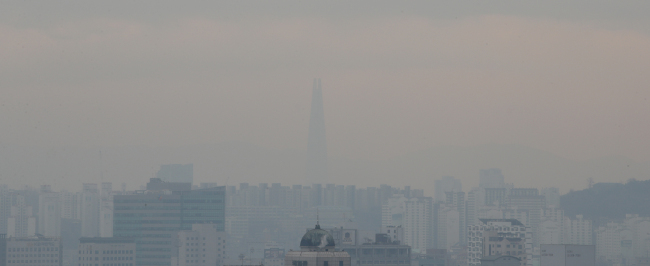South Korea has nearly the worst air quality among advanced economies, with its level of fine dust soaring over the past 25 years, a report revealed Thursday.
According to the “State of Global Air 2017,” a report by nonprofit environmental group Health Effects Institute in the United States, the nation’s average population-weighted concentration level of PM2.5 -- which refers to ultrafine particles or particle matter with a diameter of at least 2.5 micrometers -- was 29 micrograms per cubic meter in 2015, above the average 15 micrograms for the Organization for Economic Cooperation and Development countries.
 |
Fine dust covers the cityscape of Jongno-gu and Lotte World Tower in Jamsil, Seoul, on Thursday. (Yonhap) |
South Korea’s reading trailed only Turkey among the OECD.
The study showed the dust problem grew worse in South Korea, while the OECD average had improved in the past 25 years. In 1990, the PM 2.5 figure was 26 micrograms, compared to the OECD average of 17 micrograms.
When compared to other Asian countries, the quality of air in Korea is more polluted than Japan and Singapore, which scored 13 micrograms and 19 micrograms, respectively.
China recorded 58 micrograms, followed by North Korea at 34 and Laos at 33.
The latest survey came as South Koreans debate the cause of the deteriorating air condition, crucial for deciding on measures to curb it.
While many have pointed to China as the main culprit, the South Korean government highlights emissions from diesel engine cars and business sites dealing with construction waste or using solid fuel.
The Environmental Ministry last June came up with fine dust countermeasures, including a weekly no-driving campaign and gradually cutting down on benefits given to diesel car owners, with an aim of improving the country’s air quality to levels equivalent to European countries in 10 years.
However, the government’s plan did not gain wide support from the public.
A survey of 1,000 citizens conducted by the state-run Korea Environment Institute last September showed that 53.1 percent of Koreans were dissatisfied with the government’s handling of the fine dust situation, while 55.2 were worried about the current dust concentration.
“I have always thought the fine dust came to Korea through wind from China. Instead of blaming the citizens for causing the dust, the government should make more efforts to stop its influx from China,” Kim Hee-jung, a university student said.
An online community site was also established last May where members gather to demand solutions to the dust problem from the government. In less than a year, membership had expanded to some 30,393 across the country.
While high population density and rapid industrialization are also cited as driving the high concentration of fine dust in South Korea, citizens raise questions as to the possible influx of the harmful particles from outside the peninsula.
In early January, a separate study conducted by the KEI showed that about 70 percent of fine dust particles found in South Korean skies came from neighboring Northeast Asian countries such as China.
Pundits and analysts said that for a more accurate analysis on the impact from other countries, more data needs to be shared between them.
“I cannot say the KEI’s conclusion about (the source of) 70 percent of the fine dust in the country is perfectly accurate. However, it is true that China may have influenced the concentration level of the dust in Korea,” Park Jong-gil, chief of the Atmospheric Environmental Information Research Center of Inje University, said.
“China is not so fond of giving (others) their meteorological information, which makes it hard us to compare the elements of fine dust in the two countries. More cooperation is needed.”
By Jo He-rim (
herim@heraldcorp.com)





![[Weekender] Korea's traditional sauce culture gains global recognition](http://res.heraldm.com/phpwas/restmb_idxmake.php?idx=644&simg=/content/image/2024/11/21/20241121050153_0.jpg)


